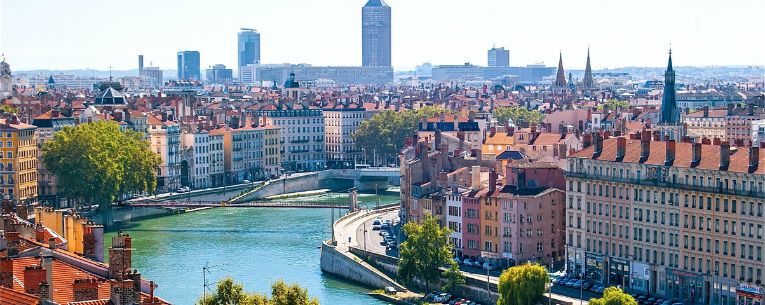Food is no trifle in France. The nation is home to some of the world’s most renowned dishes and culinary destinations. For the French, eating is an event, to be savored – both the meal and the company. Here is a sample of the stellar regions and cities for food and wine in France.
(Before you get too carried away with visions of consuming fromage with gusto, be sure to consider some practical details. International travel has rebounded post-pandemic, leading to endless airport delays. If your flight is delayed for a covered reason, Travel Delay benefits from Allianz Partners may reimburse eligible expenses for meals, accommodations and transportation.)
Lyon
France’s third largest city and home to more than 4,000 restaurants, Lyon has been known as the “gastronomic capital of the world” since 1935. But Lyon has a culinary history reaching back to the Renaissance period, when it became known for a cuisine that centers offal, innards and charcuterie, and was considered the larder of France. Beginning in the 18th century, local female chefs known as Mères Lyonnaises, or the “Mothers of Lyon,” further pioneered Lyonnaise fare, known for being hearty and meat-centered. These talented women cooked for bourgeois families before opening their own renowned restaurants. One such woman in the 19th century was Mère Brigousse, renowned for her quenelle dumplings, called tétons de Vénus and molded in the shape of breasts.
Lyon really does offer the best of France. Its location in the southeast makes it an agricultural hub, with a cuisine influenced by wine and olive oil from the far south, and Charolais beef and cream and butter from the north. The city’s location in the marshy Dombes results in dishes featuring crayfish, frogs and snails – staples that have long shaped French cooking.
What to eat: Poulet à la forestière is a local main of chicken served with a creamy mushroom sauce. Quenelle de brochet is a dumpling served with a sauce made of crayfish from Nantua Lake.
What to drink: Lyon is located between two important and diverse wine regions – Burgundy and The Rhone. You really can’t go wrong sampling wines in a place with such broad offering.
Where to dine: For rustic, traditional food in Lyon, eat at a bouchon; a type of tavern that once served silk workers that inhabited the city in the 16th and 17th centuries. The Comptoir Abel is known to be the most authentic bouchon. For another taste of history, head to the Paul Bocuse restaurant, named for the chef most responsible for bringing Lyonnaise cuisine to the world.
Provence
In contrast to hearty Lyonnaise fare, food in Provence is light and Mediterranean. Provencal cuisine largely centers fish, vegetables, olive oil, garlic and herbs. Here, dishes are uncomplicated, seasonal and familial. This southern region is also known for its weekly, outdoor village-markets, where you can stock up on vegetables, bread and other staples if you’re doing your own cooking in France.
If you’re in Provencal port Marseille, the oldest city in France, you have the chance to savor seafood dishes influenced by Spain, North Africa and Italy. As a whole, Provencal cuisine was strongly influenced by the ancient Greeks, who founded Massalia (Marseille) around 600 BC. The Greek culinary contribution includes aromatic plants, wine and salted pork. The Romans brought spices and other condiments that continue to liven Provencal cooking. Local chickpeas, lentils, goat cheese and truffles also feature heavily.
What to eat: Ratatouille, a vegetable dish of eggplant, onions, zucchini, bell peppers and tomato is the perfect, simple accompaniment to roasts, fish or eggs. It can also be served cold as an appetizer. Similar to minestrone, Soupe au Pistou is a bean and pasta soup featuring garlic, olive oil, parmesan, legumes, tomatoes and Provencal vegetables. It’s served lukewarm and is a light, summer dish.
What to drink: Provence is famous for its incredible rosé wine, which accounts for 75 percent of the region’s wine production. Provence rosé wines are traditionally made with a blend of at least two grapes, which yields bright and imaginative flavors.
Where to dine: Le Petit Nice Passedat is a stunning hotel-restaurant on a rocky point overlooking the Mediterranean. It’s also one of the world’s best seafood restaurants. Passedat’s dishes showcase fish and shellfish caught the same day. Try the sea anemone beignets with seaweed sauce, and the sea bass in herb bouillon with chopped tomatoes. Le Bords de Mer takes an inventive approach to southern French dishes. One such item is their ravioli filled with Cevennes onions, saffron, butter, lemon and sage.
Alsace
The region shares a border with Germany along the Rhine River. And throughout history, Alsace has vacillated between flying either the German or French flag. So, it makes sense that this close tie between both nations has had an interesting influence on Alsatian cuisine. Sausage and charcuterie are mainstays of Alsatian dishes. Soups and tarts that are uniquely French are blended with German elements, such as sweet onion. Choucroute, known more universally as sauerkraut, is served with sausage and other meats. The area also has its own north European pizza, Tarte Flambee; a pastry covered in crème fraiche, onions, mushroom, smoked ham and cheese. In Alsace, the famous French main of Coq au Vin is instead a Coq au Riesling.
What to eat: Alsace is known for its various tartes, and the Tarte à L'Oignan is a particularly scrumptious variation. Similar to a quiche, the dish is made with eggs, cream and onion. Bäckeoffe is a hearty casserole made with assorted meats, potatoes and leeks.
What to drink: Indicative of the region’s strong German influence, dry Reislings and other white wines are popular in Alsace. To be completely immersed in the Alsatian wine scene, follow the Route des Vins d'Alsace, or Alsatian Wine Route, along 75 miles through hundreds of towns to sample to best wines the region has to offer.
Where to dine: Au Bon Coin is a small, traditional pub near the city of Colmar, in a village well-loved by fans of Alsatian wine. Its Choucroute is known to be the best in the area. Try a bit of everything at the Le Cercle des Arômes, which has an impressive list of over 180 wines by the glass, paired with a tapas menu.
Get a quote to find out how Allianz Travel Insurance can make your food and wine tour of France headache-free.
What Do I Need to Travel to France?








Share this Page